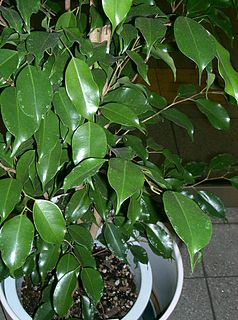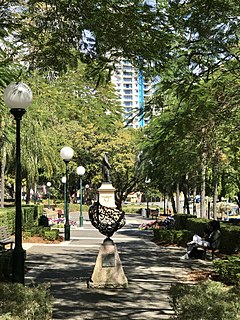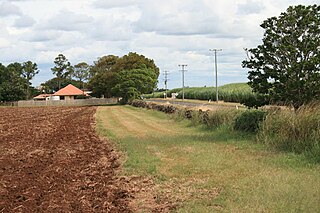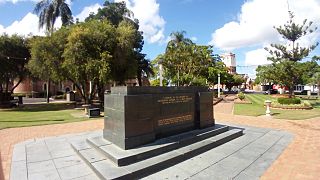
Bundaberg is a city in south-east Queensland, Australia, about 385 kilometres (239 mi) north of the state capital, Brisbane. It is 15 kilometres (9.3 mi) inland from the Coral Sea coast and situated on the Burnett River. It is a major centre within the broader Wide Bay–Burnett geographical region

Ficus benjamina, commonly known as weeping fig, benjamin fig or ficus tree, and often sold in stores as just ficus, is a species of flowering plant in the family Moraceae, native to Asia and Australia. It is the official tree of Bangkok. The species is also naturalized in the West Indies and in the states of Florida and Arizona in the United States. In its native range, its small fruit are favored by some birds, such as the superb fruit dove, wompoo fruit dove, pink-spotted fruit dove, ornate fruit dove, orange-bellied fruit dove, Torresian imperial pigeon, and purple-tailed imperial pigeon.

Bowen Park is a heritage-listed park of 17,740 square metres (191,000 sq ft) at O'Connell Terrace, Bowen Hills, City of Brisbane, Queensland, Australia. It was built from 1863 to 1950s. It was also known as the Acclimatisation Society Gardens. It was added to the Queensland Heritage Register on 26 February 1999.
A fig tree is any of about 850 species of woody trees in the genus Ficus.

Bundaberg Central is a suburb of Bundaberg in the Bundaberg Region, Queensland, Australia, containing its central business district.

Queen's Park is a heritage-listed botanic garden at Sussex Street, Maryborough, Fraser Coast Region, Queensland, Australia. A reserve for the botanical gardens was gazetted in October 1873. It contains the Maryborough War Memorial. It was added to the Queensland Heritage Register on 21 October 1992.

Walter Adams (1830–1892) was a politician in Queensland, Australia. He was a Member of the Queensland Legislative Assembly.

Ithaca Embankments is a heritage-listed group of embankments in the former Town of Ithaca and now in the suburbs of Kelvin Grove, Red Hill and Paddington in Brisbane, Queensland, Australia. They were designed by Alexander Jolly and built from c. 1917 to c. 1923. They were added to the Queensland Heritage Register on 2 March 1993.

Centenary Place is a heritage-listed park at 85 Wickham Street, Fortitude Valley, City of Brisbane, Queensland, Australia. It is also known by some as Centenary Park even though this is not the name it was given at the ceremonial dedication. It was designed by Henry Moore. It was added to the Queensland Heritage Register on 6 August 2007.

Eagle Street Fig Trees is a heritage-listed group of trees at 118A Eagle Street, Brisbane City, City of Brisbane, Queensland, Australia. They were planted c. 1889 by Walter Hill. It is also known as Fig Tree Reserve and Plantation Reserve. It was added to the Queensland Heritage Register on 13 May 2004.

Bundaberg School of Arts is a heritage-listed former school of arts and now community centre at 184 Bourbong Street, Bundaberg Central, Bundaberg, Bundaberg Region, Queensland, Australia. It was designed by Anton Hettrich and built from 1888 to 1889. It was added to the Queensland Heritage Register on 21 October 1992.

Commercial Bank of Sydney is a heritage-listed former bank building at 191–193 Bourbong Street, Bundaberg Central, Bundaberg, Bundaberg Region, Queensland, Australia. It was designed by George Allen Mansfield and built in 1891. It is also known as the National Australia Bank. It was added to the Queensland Heritage Register on 21 October 1992.

Kennedy Bridge is a heritage-listed road bridge on Bourbong Street crossing Bundaberg Creek from Bundaberg Central to Bundaberg East in Bundaberg, Bundaberg Region, Queensland, Australia. It was designed by Alfred Barton Brady and built in 1899. It is also known as Saltwater Creek Road Bridge. It was added to the Queensland Heritage Register on 21 October 1992.

Sunnyside Sugar Plantation is the heritage-listed remains of a former sugar plantation at 94 Windermere Road, Windermere, Bundaberg Region, Queensland, Australia. It was built in c. 1880s by South Sea Islander labour. It is also known as Dry-rubble Boundary Wall. It was added to the Queensland Heritage Register on 13 May 1996.

Fig Tree is a heritage-listed tree at Roseberry Street, Gladstone, Gladstone Region, Queensland, Australia. It was planted c. 1903. It is also known as Heritage Tree. It was added to the Queensland Heritage Register on 3 December 2003.

Big Fig is a heritage-listed tree at Station Street, Miriam Vale, Gladstone Region, Queensland, Australia. It was added to the Queensland Heritage Register on 6 January 2004.

Row of Street Trees is a heritage-listed avenue of trees at Macrossan Street, Halifax, Shire of Hinchinbrook, Queensland, Australia. The trees were planted c. 1885. The trees were added to the Queensland Heritage Register on 6 September 2003.

Buss Park is located in Bundaberg Central, Bundaberg, Bundaberg Region, Queensland, Australia. It borders the Anglican Christ Church and the Bundaberg Regional Council offices and contains several memorials. The centrepiece of the landscaped gardens is the granite cenotaph to pioneer aviator Bert Hinkler.

Bundaberg Central State School is a heritage-listed state school at 13 Crofton Street, Bundaberg Central, Bundaberg, Bundaberg Region, Queensland, Australia. It was designed by Robert and John Ferguson and the Queensland Department of Public Works and built in 1890 by William Calvert. It is also known as Bundaberg South State School. It was added to the Queensland Heritage Register on 28 November 2014.

Bundaberg Post Office is a heritage-listed post office at 155a Bourbong Street, Bundaberg Central, Bundaberg, Bundaberg Region, Queensland, Australia. It was added to the Australian Commonwealth Heritage List on 8 November 2011.

























